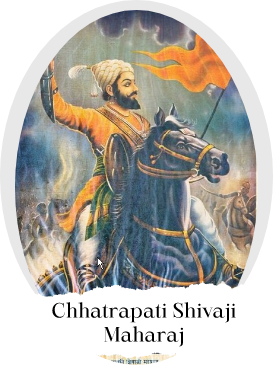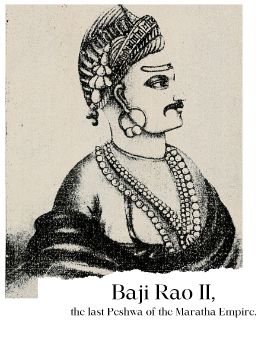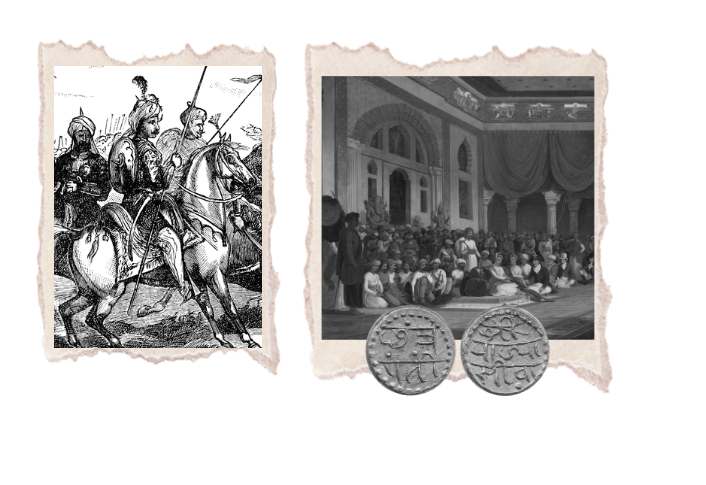Nature of State and Kingship
After the death of Shivaji, the condition in Maratha country was not normal. When
Shahu ji, the grandson of Shivaji was released from Mughal prison in 1707, the
machinery of government that Shivaji had created had almost collapsed. Several
Maratha leaders independently organised armies, led expeditions into Mughal
territory, and collected revenues for their own expenses. Shahu ji had the good
judgment to ally with Balaji Vishwanath and, later with his son Bajirao Ballal, who
were great military leaders as well as able administrators. [5] When
Balaji Vishwanath became Peshwa in 1713, he realise that the system of government
devised by Shivaji, in which the king (Chatrapati), who was the sole ruler of his
dominion and who ruled with the help of his eight ministers (Astapradhan), was no
longer viable system. The king's standing against his own warlords was not only
weakened but later also became were effectively independent from the authority of
the former. Thus, to keep the kingship of Shivaji house from falling and prevent the
country being involved in civil war, Peshwa Balaji Vishwanath created a new polity
in which Maratha chiefs called Sardars were accepted as vassals with almost free
reign over their territory. This was done by recognising them as hereditary
jagirdars (a feudal class who collected taxes as a form of revenue and has a power
of governing their territory). In return, they bring their forces to the service of
Peshwa who rule on the name of Chatrapati whenever called upon. But otherwise
Sardars had a free hand in the management of their jagirs and ruled as a
semi-independent ruler.[6]
Baji Rao conquest in all directions inspired other Maratha chiefs to extract a
kingdom of their own by their own conquests made them more independent and difficult
to control. The Scindias of Gwalior and Ujjain, Gaekwads of Baroda, Holkars of
Indore and Malwa, and Bhonsales of Nagpur emerged this way. This Maratha Confederacy
though sprawled over a large part of Indian subcontinent.
This period saw many brilliant Maratha administrators and military commanders like
Mahadji Scindia who made Mughal emperor a puppet in his hand, Ahilyabai Holkar,
Queen of Indore, who is well known for her civil, military, and revenue
administration, and Nana Fadnavis, a great statesman was known for his
administrative, diplomatic, and financial skills. Notice what Jawaharlal Nehru
writes about Ahilyabai, in The Discovery of India (1946):
“The reign of Ahilyabai, of Indore in central India, lasted for thirty years.
This has become almost legendary as a period during which perfect order and good
government prevailed and the people prospered. She was a very able ruler and
organizer, highly respected during her lifetime, and considered as a saint by a
grateful people after her death."
The Central Administration
The Huzur Daftar at Poona, which served as the Peshwas' secretariat, was the focus of
Martha's central administration. It was a huge establishment with numerous
departments and bureaus. The work of the Huzur Daftar included maintaining accounts
alienations of public revenue, whether Saranjam (grant of land for maintenance of
troops for military service), Inam, or otherwise, of the troops, and the expense of
all civil, military, and religious establishments.[9] Besides, all
accounts rendered to the government of the revenue and expenditure of the districts
and those of the villages, farms and customs was also managed by the Peshwa
secretariat. The office of Huzur Daftar maintained the accounts of all contributions
and exactions levied on foreign states in a daily register called Rozkirds. The
entire collection of records was taken into account and displayed in the Turjamas in
one comprehensive view. Perhaps the most important departments that worked under
Huzur Daftar were the EL Beriz Daftar and the Chalte Daftar. The former, which was
based in Poona and dealt with accounts of all kinds, kept categorised accounts, a
balance of the State's annual income, and a Khataunis-abstract of every expenditure
arranged alphabetically. As far as Chalte Daftar is concerned, a class of official
called Fadnavis had complete control over it. Many reforms to the Huzur Daftar's
operation were instituted by Nana Fadnavis, but the system collapsed under the last
Peshwa Baji Rao II. [10]
Provincial and District Administration
Shivaji, in accordance to his nationalising principles divided his dominions into
Mauja, Tarf and Subha. During the Peshwa period, however, the terms Tarf, Pargana,
Sarkar, and Subha are all used interchangeably. But the Subha was also called a
Prant whereas Tarf and the Parganas eventually became characterised as Mahals. The
officials known as Kamavisdars were put in charge of the smaller divisions, while
the Mamlatdars were responsible for the larger ones. The Mamlatdars held their
office directly under the central government except in the three provinces of
Khandesh, Gujrat and the Karnataka, where they were placed under officers called as
Sarsubhedars. Thus, in Karnataka, Sarsubhedar was responsible for collecting taxes
and appointing his own Mamlatdars, but in Candeish (present-day southwest MP), he
just exercised general supervision, with individual Mamlutdars responsible for
collecting and remitting taxes directly to the government.[11]
Thus, the backbone of the Maratha district administration was supplied by the
Mamlatdars, who was in charge of a division styled pargana or prang, and by his
subordinate or deputy known as Kamavisdar, who administered a smaller territorial
area of the same kind. In fact, both of them were Peshwa representatives in the
district. They were men who handled a variety of responsibilities, including the
growth of the agricultural and industrial sectors, civil and criminal justice,
management of the local militia, and police. They even mediate social and religious
disputes. The Mamlatdar determined the revenue assessment of the villages in the
districts after consulting with the Patels of the villages. When necessary, the
Mamlatdar made a Shibandi (local militia) ready to help the Patel with revenue
collection.[12] The Mamlatdar combined in himself executive and judicial
functions, but he was not the complete autocrat because his power was restrained by
customs and check of hereditary zamindars and darakhdars who was the officers
appointed from central government in each pargana. Darakhdars were directly
subordinate to the Peshwa, and reported direct to the Government in Poona. Thus, at
the local level, officials were eight in number, viz., the Diwan or Mamlatdar
deputy, Phadnis, Muzumdar, Daftardar, Potnis, Chitnis and Sabhasad. They were
supposed to serve as a check on one another as well as the Mamlatdar, who had no
authority to fire any of them.[13]
Other officers who functioned as checks on Mamlatdar included the Deshmukh and
Deshpande, and no account was approved unless corroborated by corresponding accounts
from both of them. The Karkuns in the districts were also completely independent who
reported any deviations of the functioning of the local government directly to
Poona. The smaller administrative divisions known as Mahals or Tarfs run according
to the same rules as of the district. The Havaldar was the chief officer in a mahal,
who was aided by a Mazumdar and a Fadnavis.[14]
Village Administration
The change of the dynasty at the upper levels in the state did never affect much of
its village organization where government hardly interfered with their internal
autonomy. In the Peshwa rule also the self-contained village remained the primary
unit of administration. Each village had a headman, the Patel, who came from peasant
stock and who combined the functions of revenue officer, magistrate and judge, and
acted as intermediary between the village and Government officials. His position was
hereditary and subject to sale and purchase, despite the fact that the government
had granted him the position. His emoluments, which varied slightly from village to
village, consisted of rent-free lands and receipts from each villager for a certain
share of his produce. The Patel was also expected to shoulder the responsibility for
the village’s welfare and good conduct. The village clerk and record-keeper known as
the Kulkarni was a Brahmin and received many perquisites like the Patel. He shared
the Patel's duty for the village's good behaviour and risked imprisonment by casual
invaders or tyrannous officials. Another important local officer responsible for
efficient functioning of village administration was the Mahar. He was the village's
watchman. He was familiar with boundaries of individual fields, kept an eye on
everyone who passed through the village and protect village from for thieves and
criminals. He delivered government treasure to pargana headquarters. [15]
Revenue & Taxation
The revenue policy of the Peshwas was based on the principle of securing the
prosperity of the tax payers. Since agriculture was the principal occupation of
India, land revenue served as the primary source of income for the Peshwas. Maratha
Confederacy followed Shivaji’s policy of encouraging cultivators to bring more and
more land under cultivation and most importantly, they taxed newly lightly the new
land brought under cultivation. Peshwa Madhavrao II announced that half of such land
would be given in inam and for the remaining half rent-free concessions would be
provided for twenty years with subsequent tax breaks for a further five years.
Remission of land revenue was granted at times of famine, drought, and the
plundering of harvests or the failure of crops. The Maratha State also provided
cultivators with loans known as Tagoi at rates of interest that were significantly
lower than those offered by traditional moneylenders. [16]
Judicial Administration
Nowhere perhaps the influence of the ancient Hindu law-givers is more perceptible
than in the judicial system of the Marathas. The Marathas law was based on the
Manu’s code and Mitakshara School of Law derived from the Yajnavalkya Smriti. The
civil as well as criminal justice was administered in a much simpler way where the
community was left to its own resources to get its disputes settled. The judicial
officer in the village was the Patel, in the district – the Mamlatdar, above him the
Sarsubahdar and then the Peshwa. Above all was the Raja of Satara, from the House of
Chatrapati who was the fountain of justice and honour.
In towns judicial duties were entrusted to the acre of a Nayayadhish who was
well-versed in the shastras and who performed judicial functions only. Thus the
separation of the judicial functions from the executive was known to the Marathas.
For serious crimes like robbery, murder, treason, the usual punishment was
confiscation of property, imprisonment of the criminal or mutilation.[17]
The highway robbery was punished with death. Women were never put to death. Despite
harsh punishments, ordinary prisoners were well-treated. They were permitted to go
home to perform religious ceremonies. Sometimes the relations of the prisoners were
allowed to live with them and they were fed by the Government. The incredible
feature of Maratha judiciary was that punishment was meant to reform the culprits
rather than driving them to the extreme of despair and making them a hardened
criminal. [18]








